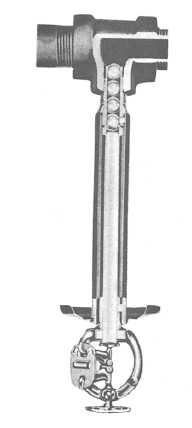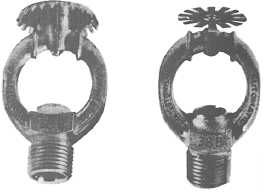A dry pendent sprinkler (fig. 8-18) is used when pendent sprinklers must be placed on dry pipe systems or in wet pipe systems when the area to be protected is subject to freezing (such as a walk-in reefer or outside shop area) and the piping network is installed in a heated area. This sprinkler is fitted with a tube within an attached pipe. The tube holds the water sealing elements in place against a watertight seal at the top of the pipe. When the sprinkler is actuated, the tube drops down and releases the elements through the tube and out the open sprinkler with the water discharge.
Open sprinklers consist only of a sprinkler frame and deflector. They are used on special sprinkler systems such as deluge or rapid reaction systems (fig. 8-19).
Water spray nozzles (fig. 8-20) are used for special application of water in various patterns (for example, wide or narrow angle, long throw or flat patterns). The different patterns may be achieved by either internal or external deflection of the water stream depending on the type of nozzle.

Figure 8-18. - Dry pendent automatic sprinkler.
SPRINKLER SYSTEM DETECTION AND INDICATING DEVICES AND FITTINGS
Sprinkler systems have many different controlling devices and fittings. These can be classified as detecting or initiating devices or fittings. Their function is to detect system operation and to initiate system operation or alarm systems connected to the sprinkler system. This section discusses these devices and fittings to aid you in installing and troubleshooting sprinkler systems and understanding the interface between the mechanical and electrical functions of these devices.
Water-Flow Actuated Detectors
Sprinkler water-flow detectors are generally pressure-actuated or vane-actuated. Pressure switches are used on both wet and dry pipe systems. Vane switches are widely used on wet pipe sprinkler systems. They cannot be used on dry pipe systems because the initial rush of water into the pipe could damage the vane and mechanism.
Dry pipe system alarms tend to be slow-acting because it takes time to lose sufficient air through a fused sprinkler to trip the system. Various methods are used to speed up dry pipe systems as discussed earlier.
Wet pipe system alarms have a different problem. Fluctuating water pressure frequently causes flow into a sprinkler system, equalizing the sprinkler system pressure with the supply pressure. Such surges of water or of pressure cause false water-flow alarms if some method of slowing

Figure 8-19. - Open sprinklers.
Continue Reading